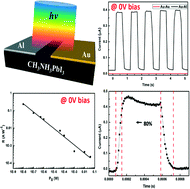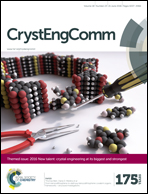A self-powered photodetector based on a CH3NH3PbI3 single crystal with asymmetric electrodes
Abstract
Methylammonium lead iodide perovskite (MAPbI3) has made a re-entry into the literature nowadays for its extraordinary characteristics, such as high absorption of light, long carrier diffusion length, high carrier mobility, low trap-state density, low surface recombination velocity and ease of attainment. Here, we report a self-powered photodetector based on a CH3NH3PbI3 single crystal by employing asymmetric Au–Al electrodes. The key issue of this photodetector was the metal–semiconductor contacts, owing to the Schottky junction between them. By setting the channel length between the Au–Al electrodes to 30 μm for sufficient electron–hole pair separation and transportation, the device showed good performance under 1 sun illumination. The short-circuit photocurrent density and open-circuit voltage were 6.86 mA cm−2 and 0.7 V, respectively. The photocurrent was almost 2 orders of magnitude larger than that based on a perovskite polycrystalline film with a similar device structure. More importantly, the device could detect the lowest noticeable incident power density down to 1 × 10−8 W cm−2. Under this weak light intensity, the responsivity was as high as 0.24 A W−1 without any bias. The photoresponse also had a broadband ranging from 375 nm to 808 nm accompanied by a fast response speed.

- This article is part of the themed collection: 2016 New talent

 Please wait while we load your content...
Please wait while we load your content...